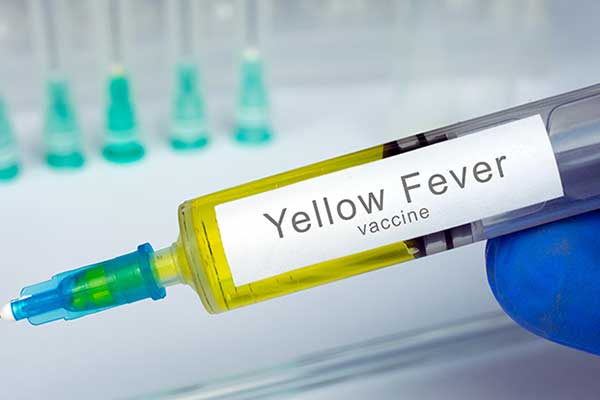There has never been a Canadian outbreak of Yellow Fever. There have, however, been epidemics of it in northern cities of the United States, including Boston.
This raises a few questions, like how can you tell if someone has Yellow Fever? How is it spread, and how is it treated? Can it be treated, or is prevention more effective?
Knowing about Yellow Fever can be important, and may help you save someone's life someday. We'll go into more detail about Yellow Fever and what we know about it in the paragraphs below.
Let's Breakdown Yellow Fever
According to WHO website, Yellow Fever is an acute viral haemorrhagic disease transmitted by infected mosquitoes. The "yellow" in the name refers to jaundice that affects some patients.
Yellow Fever is a tropical disease and most often occurs in South America, north of Argentina, and in Africa, between Egypt and Namibia. Africa poses the biggest threat, with 9 out of every ten cases occurring there.
Yellow Fever is one of the family of viruses known as Flaviviridae, which also includes other popular viruses like Dengue Fever, West Nile Virus and Zika Virus.
The Symptoms
At first glance, the symptoms of Yellow Fever may resemble a bad flu. They may include head and body aches, dizziness, nausea, vomiting, light sensitivity, fever, and a reddening of the face, eyes, and tongue.
These occur during the first phase of Yellow Fever, and, thankfully, there usually isn't a second phase. That being said, for those who do experience a second phase, Yellow Fever is often fatal.
Phase 2 of Yellow Fever is known as the Toxic Phase. During the Toxic Phase, all or some of the symptoms from the initial phase return, and are joined by jaundice, or yellowing of the skin and eyes. This is where Yellow Fever gets its name.
Jaundice occurs because red blood cells within the body are dying and releasing a yellow substance in the process. This substance is natural, but it isn't supposed to be released in significant amounts.
Someone in the Toxic Phase may also experience bleeding from their mouths, their eyes, and even their nose. If the person is vomiting, that may also be bloody.
Their urinary output will decrease and perhaps stop entirely as their kidneys and liver shut down. Their heart rate will slow, and as less blood gets to their brain, they may have delusions, extreme confusion, seizures and even fall into a coma.
The Causes
One of the shared features of these conditions is that they all are, or can be, spread by mosquitoes. As far as the scientific community is concerned, you can't get Yellow Fever from another person or from a monkey, which is another common host for this disease. Some believe that sharing needles may cause Yellow Fever to spread, but this hasn't been proven.
Yellow Fever may not be contagious, but it's also not uncommon. There are roughly 200,000 cases of Yellow Fever per year, despite the fact that it's only present on two continents.
Not all mosquitoes spread this illness. Yellow Fever is primarily concentrated in South America and central Africa and spread by several different species of mosquitoes.
Yellow Fever is an interesting illness in that symptoms will usually disappear within a week. This is the extent of it most of the time. However, a significant minority of people will see symptoms return within a day, and that's when the disease gets dangerous.
If left untreated, Yellow Fever can cause multiple organs to shut down and will eventually kill the sufferer.
Is Yellow Fever Treatable?
Yellow Fever is interesting because it technically has no cure. However, modern medicine and medical care can increase the odds of survival for those with Yellow Fever.
The best way to deal with Yellow Fever is prevention. We've had a vaccine for it since 1951. It's one of the many vaccines that are required for travel to certain countries, especially those where Yellow Fever is endemic.
The good news is that the Yellow Fever virus doesn't mutate very quickly or effectively. As a result, the vaccine for Yellow Fever is effective for an entire lifetime. It's also been found that the immune system does learn to fight the disease because if you survive Yellow Fever in your lifetime, there doesn't seem to be a risk of getting it again.
If you do contract Yellow Fever overseas, don't worry about the cost. Many types of travel insurance cover emergency medical treatments.
Where Do I Get the Vaccine for Yellow Fever?
The phrase 'Yellow Fever vaccine' isn't one most of us hear very often. However, that doesn't mean they're hard to find or uncommon. You can get them in many different places.
There are plenty of licensed doctors in Canada who have been approved to give the vaccine. There are also some pharmacies that are authorized to vaccinate patients against Yellow Fever.
If you aren't sure where to get travel vaccines, you might want to mention them to your doctor. They may have connections within the medical field that offer travel vaccines.
How Much Does it Cost?
Perhaps you're worried about cost, which is understandable. However, some insurance companies cover vaccinations that are required for travel.
Without the right insurance, vaccinations can be somewhat expensive, but it's not impossible to pay for them. Travel vaccinations can cost anywhere from $100 to $400 out-of-pocket. Keep in mind that this isn't specifically for the Yellow Fever vaccine, but for all required travel vaccines.
Yellow Fever: A Brief Guide
Entire books have been filled with information about Yellow Fever, so obviously we couldn't cover everything. Instead, we condensed as much practical information as we could into this article, including information about insurance that might help you in your travels.
If you want to know more about insurance or are in the market for insurance, please visit our site.


